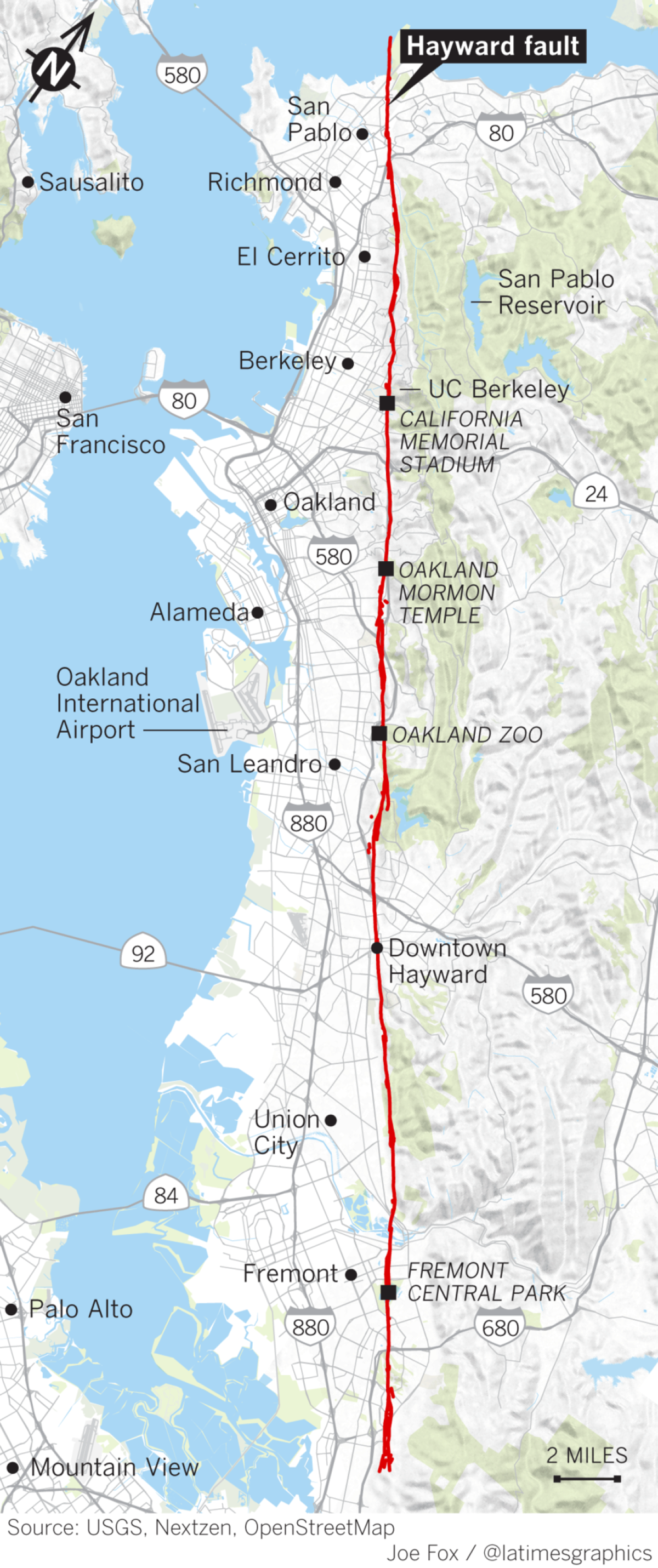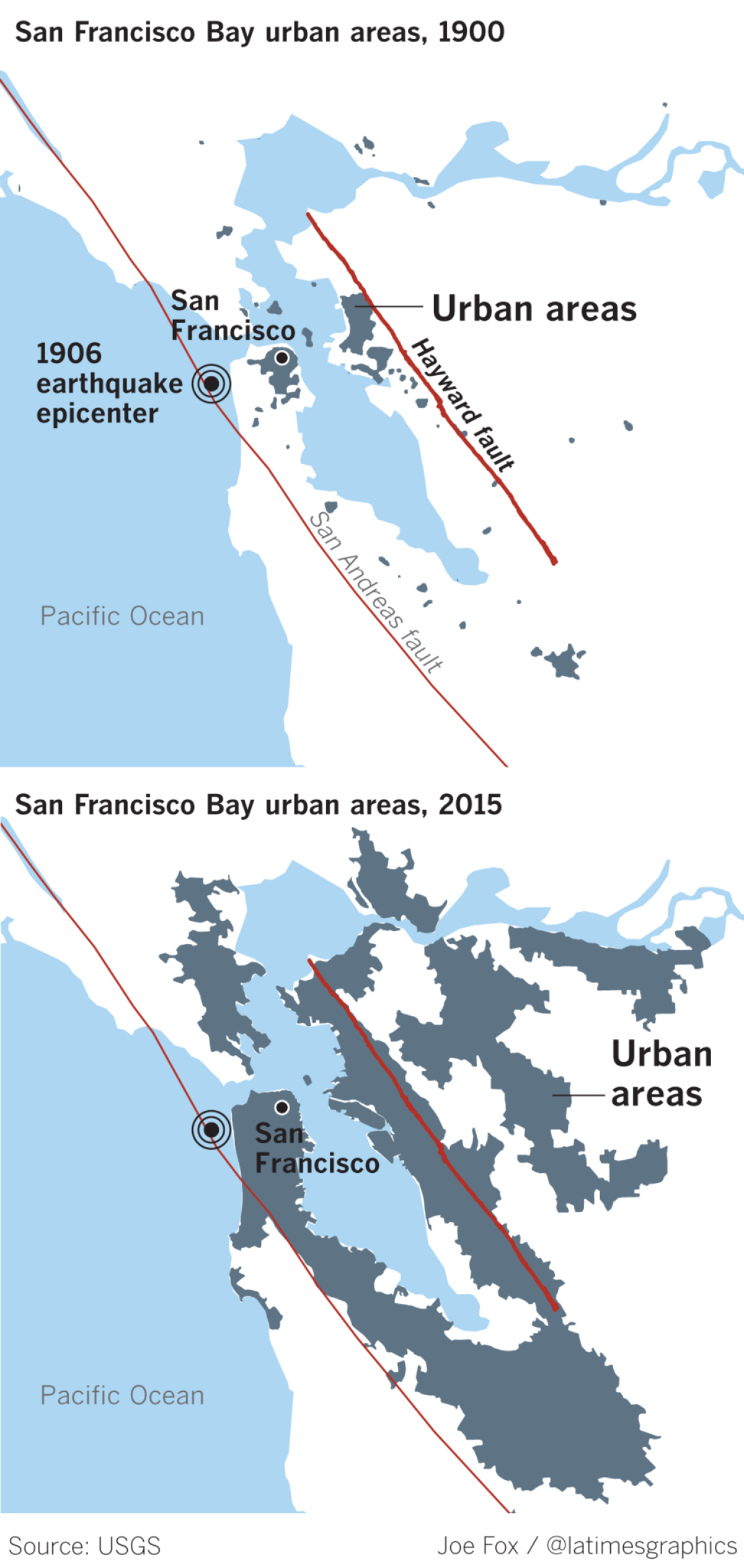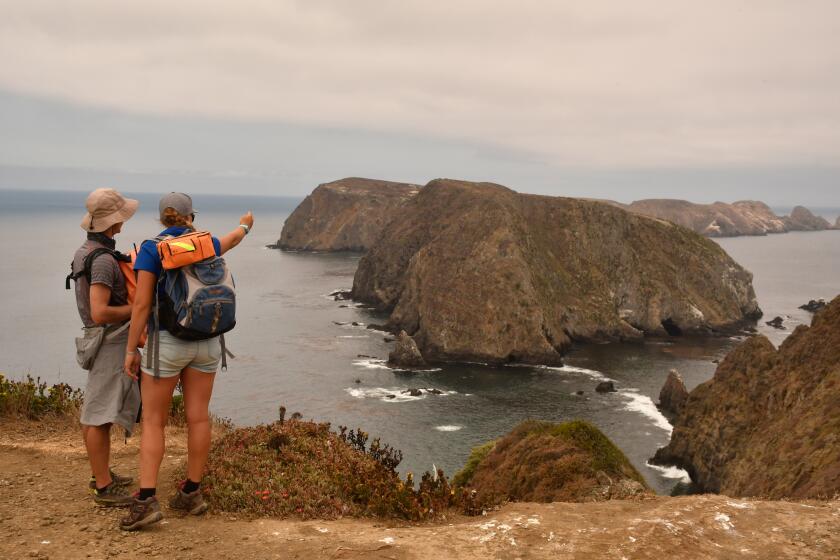East Bay fault is ‘tectonic time bomb,’ more dangerous than San Andreas, new study finds

Why the Hayward fault is one of California’s most feared, as explained by U.S. Geological Survey geologist David Schwartz.
- Share via
The San Andreas long has been the fault many Californians feared most, having unleashed the great 1906 earthquake that led to San Francisco’s destruction 112 years ago Wednesday.
But new research shows that a much less well-known fault, running under the heart of the East Bay, poses a greater danger.
A landmark report by the U.S. Geological Survey estimates that at least 800 people could be killed and 18,000 more injured in a hypothetical magnitude 7 earthquake on the Hayward fault centered below Oakland.
Hundreds more could die from fire following an earthquake along the 52-mile fault. More than 400 fires could ignite, burning the equivalent of 52,000 single-family homes, and a lack of water for firefighters caused by old pipes shattering underground could make matters worse, said geophysicist Ken Hudnut, the USGS’ science adviser for risk reduction.
“This fault is what we sort of call a tectonic time bomb,” USGS earthquake geologist emeritus David Schwartz said. “It’s just waiting to go off.”
The Hayward fault is so dangerous because it runs through some of the most heavily populated parts of the Bay Area, spanning the length of the East Bay from the San Pablo Bay through Berkeley, Oakland, Hayward, Fremont and into Milpitas.
Out of the region’s population of 7 million, 2 million people live on top of the fault, Schwartz said, and that proximity brings potential peril. The 1989 Loma Prieta earthquake was centered in the sparsely populated Santa Cruz Mountains. For all the devastation of the 1906 San Francisco earthquake, it was centered off the coast in the Pacific Ocean.

As the potential hazards of the fault have become clearer in recent years, officials have begun to take action. Old city halls in Hayward and Fremont have been abandoned because they lie on the fault. At Memorial Stadium at UC Berkeley, seating was recently broken up and rebuilt so that the facility’s western half could move 6 feet northwest from the other side. In the hypothetical earthquake scenario, half of Memorial Stadium moves 2 feet northwest during the main earthquake, another foot over the next 24 hours, and yet another foot or so over the next few weeks or months, Hudnut said.
Despite taking such precautions, much of the region remains vulnerable, experts said.
The so-called HayWired scenario envisions a scale of disaster not seen in modern California history — 2,500 people needing rescue from collapsed buildings and 22,000 being trapped in elevators, Hudnut said. More than 400,000 people could be displaced from their homes, and some East Bay residents may lose access to clean running water for as long as six months.
The report found that a major East Bay quake also would outmatch California’s minimum building codes, which are designed only to keep most structures strong enough to enable people to safely evacuate. Even if all of the 2 million buildings in the greater San Francisco Bay Area complied with the modern-era building code, a HayWired scenario earthquake would cause 8,000 structures to collapse, 100,000 to be red-tagged — meaning they’re too damaged to enter — and 390,000 to be yellow-tagged, meaning occupancy is limited due to significant damage, said Keith Porter, a University of Colorado Boulder research professor who coordinated the HayWired report’s engineering section.
In some respects, the Haywired scenario would be at least 10 times as bad for the Bay Area as the magnitude 6.9 Loma Prieta earthquake, despite the similar magnitude. The 1989 earthquake is blamed for about 60 deaths and produced $10 billion in damage; the HayWired scenario envisions $82 billion in property damage and direct business losses; fire following the earthquake could add $30 billion more.
A Hayward fault earthquake could trigger significant aftershocks on other faults for up to half a year after the main shock. In the HayWired scenario, a large aftershock comes nearly six months after the main quake — a magnitude 6.4 close to Cupertino, the home of Apple’s headquarters, followed in close succession by a magnitude 6.2 temblor near Palo Alto, a key city in Silicon Valley, and a 5.4 back in Oakland.
The Hayward fault is one of California’s fastest moving, and on average produces a major earthquake about once every 150 to 160 years, give or take 70 or 80 years. The last major earthquake on the Hayward fault, a magnitude 6.8, will see its 150th anniversary on Oct. 21.
“Even given the uncertainties, we are definitely closer to the next one than we are away from it,” Schwartz said recently, while showing off the giant crack in the floor of the Fremont Community Center — built on the Hayward fault — that has slowly grown since it was built in 1962.
Strong shaking won’t affect the East Bay only, but also will be felt in San Francisco and places like the San Ramon and Livermore valleys. “You can’t hide — there’s really going to be very little places in the greater Bay Area that won’t be affected," he said.

The location of the Hayward fault is so well known to geologists because in certain parts of the East Bay, it creeps along, moving slowly between earthquakes. That releases some of the seismic strain accumulating on the fault as the Pacific plate slides northwest relative to the North American plate, but not the lion’s share.
Those close to the actual fault rupturing in the HayWired scenario may experience shaking strong enough to flip over a grand piano, seismologist Lucy Jones said. That’s why it’s a mistake for Californians to think that their home or business is fine if they survived the 1989 Loma Prieta or 1994 Northridge earthquake, neither of which was directly underneath a densely populated area with many old buildings.
“If you’re right on top of the earthquake, it’s really a lot worse,” Jones said. “What you had in Oakland in Loma Prieta is much less shaking than you’re going to get in this one.”
The HayWired report has been more than four years in the making, and federal scientists say they hope spelling out the science of what could happen in a plausible earthquake will help inspire people to get prepared.
With decades passing since the 1989 earthquake, “some amount of complacency is to be expected, and it’s the same in L.A. after Northridge,” Hudnut said. But “it’s not OK to forget. We have to remember,” he said.
Few people in the Bay Area know exactly where the fault is located, even in busy neighborhoods like Hayward’s downtown.
On a recent weekday morning, two women who said they routinely bring their children to a park next to the abandoned Hayward City Hall on Main Street had no idea that it had been closed because it was slowly being ripped apart by the Hayward fault. There are no markings showing the path of the fault, and kids routinely run up to touch the building.
“If it crumbles, that’s really scary,” said Melanie Koloto, there with her 6- and 8-year-old sons. “I think they should already have it blocked off, or try to get it knocked down.”
“At least have some kind of public safety meeting — a town hall or something — to say this is where it is, and this is the danger that comes along with sitting right on top of it,” said Katie Crystal, 32.
Signs of the fault are evident, according to Schwartz, who recently took a reporter on a tour. A bent curb and a bent building wall can be seen on the northeast side of Mission Boulevard between A and B streets. In the parking lot behind Favorite Indian Restaurant, a long bump in the asphalt shows the boundary line of the Hayward fault as the western side creeps to the northwest, and the other creeps to the southeast.
Schwartz said the fault continues in a northwesterly direction, which would point it through the property to the northwest — the St. Regis Retirement Center. The longtime owner, Gene Rapp, 80, said he was unconvinced, adding that he thinks a trench needs to be dug and studied for there to be a definitive conclusion.
“I don’t think a bump in the parking lot or a crack in the sidewalk means anything,” Rapp said in a telephone interview. “There’s only one way to know for sure. You have to dig a ditch. You can’t just look at broken concrete and jump to a conclusion. It might be a wild ass guess.”
UPDATES:
7:30 p.m.: This article was updated throughout for context.
This article was originally published at 5 p.m.
Sign up for Essential California
The most important California stories and recommendations in your inbox every morning.
You may occasionally receive promotional content from the Los Angeles Times.








